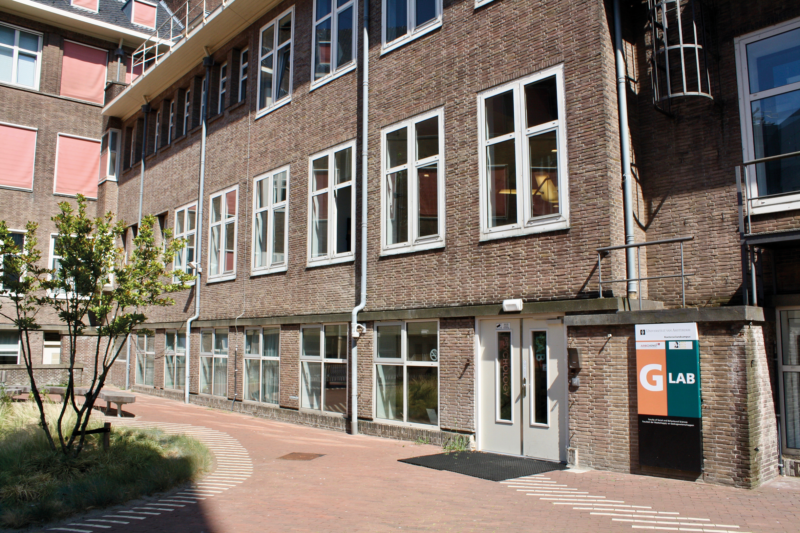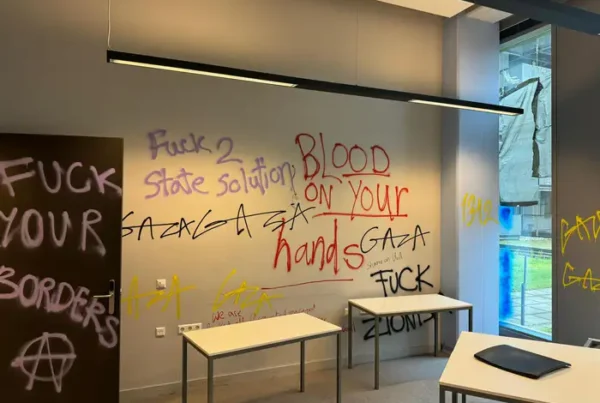

If you ever tried studying for an exam at Roeterseilandcampus (REC), you may have had the draining experience of walking up and down the library learning centre for ten minutes trying to find an empty desk. And if you ever had a tutorial in building A, B or C you may have had the ‘diverting’ opportunity of taking a tour around the buildings before – finally – managing to find your classroom.
You may actually not be particularly fond of the buildings at REC – with the exception of our dearly beloved building G, of course. Interestingly enough, the Roeters-eiland campus was nominated for a prestigious international architecture prize of the Royal Institute of British Architects, the RIBA award, last year. Not everyone was as happy about this nomination as the architects presumably were. In an open letter to the RIBA published in the Amsterdam-based newspaper het Parool (2018), a group of 69 professors, researchers and students at the UvA protested against the nomination. In their letter, they complained about problems with accessibility of the buildings for people with a physical impairment (which is, in fact, not in accordance with requirements of Dutch law for public buildings) and compared the the building’s grey, sterile and cold design to a mortuary. Moreover, the architects forgot to add a room where the cleaning staff could sit and relax during their breaks (another requirement of Dutch law) and the building hinders the contact between students and teachers by hiding the stairways leading to the teachers’ office floors (the floors above the fourth floor) behind a rather inconspicuous door. This building, the protesters write, fosters a sense of alienation.
The writers of this letter are not alone in their displeasure with the REC buildings. Matthijs van de Port, a social anthropologist at the UvA described the buildings of REC in literary magazine de Gids (2016) as ‘krulvijandig’ (‘hostile to curves’), an architecture that would ‘distort reality into clarity’ and which he described as ‘the aesthetics of power’ – whatever that might mean. The REC complex is also a little impopular with the neighbourhood’s inhabitants, who had to reside in the noise of construction works for quite a few years. And just when they believed the disturbances to finally be over, the UvA announced its intention to construct another building at the campus. In 2018 the university suddenly realized they needed another big lecture hall, in spite of having been warned about the shortage of large lecture halls at REC as early as 2013. A new building housing a big lecture hall with a capacity of a thousand students, which can be converted into smaller lecture rooms, is intended to arise between CREA and building J/K. This new building would replace a small green area referred to fondly by neighbours as het postzegelparkje, the postal stamp park, or petit Versailles. As you can imagine, the neighbours are not too happy about the plans for this new building, but since the ground is UvA property, there is very little they can do. The design that is currently in consideration has ivy growing on the sides of the building, to compensate for the loss of the postal stamp park, which might be an attempt to pacify the unhappy neighbours. Hopefully, the architects will think about practical – and legal – requirements like accessibility this time.
Roeterseiland may have been nominated for an architecture award, but there seem to be plenty of people who would rather wreck the REC.

If you ever tried studying for an exam at Roeterseilandcampus (REC), you may have had the draining experience of walking up and down the library learning centre for ten minutes trying to find an empty desk. And if you ever had a tutorial in building A, B or C you may have had the ‘diverting’ opportunity of taking a tour around the buildings before – finally – managing to find your classroom.
You may actually not be particularly fond of the buildings at REC – with the exception of our dearly beloved building G, of course. Interestingly enough, the Roeters-eiland campus was nominated for a prestigious international architecture prize of the Royal Institute of British Architects, the RIBA award, last year. Not everyone was as happy about this nomination as the architects presumably were. In an open letter to the RIBA published in the Amsterdam-based newspaper het Parool (2018), a group of 69 professors, researchers and students at the UvA protested against the nomination. In their letter, they complained about problems with accessibility of the buildings for people with a physical impairment (which is, in fact, not in accordance with requirements of Dutch law for public buildings) and compared the the building’s grey, sterile and cold design to a mortuary. Moreover, the architects forgot to add a room where the cleaning staff could sit and relax during their breaks (another requirement of Dutch law) and the building hinders the contact between students and teachers by hiding the stairways leading to the teachers’ office floors (the floors above the fourth floor) behind a rather inconspicuous door. This building, the protesters write, fosters a sense of alienation.
The writers of this letter are not alone in their displeasure with the REC buildings. Matthijs van de Port, a social anthropologist at the UvA described the buildings of REC in literary magazine de Gids (2016) as ‘krulvijandig’ (‘hostile to curves’), an architecture that would ‘distort reality into clarity’ and which he described as ‘the aesthetics of power’ – whatever that might mean. The REC complex is also a little impopular with the neighbourhood’s inhabitants, who had to reside in the noise of construction works for quite a few years. And just when they believed the disturbances to finally be over, the UvA announced its intention to construct another building at the campus. In 2018 the university suddenly realized they needed another big lecture hall, in spite of having been warned about the shortage of large lecture halls at REC as early as 2013. A new building housing a big lecture hall with a capacity of a thousand students, which can be converted into smaller lecture rooms, is intended to arise between CREA and building J/K. This new building would replace a small green area referred to fondly by neighbours as het postzegelparkje, the postal stamp park, or petit Versailles. As you can imagine, the neighbours are not too happy about the plans for this new building, but since the ground is UvA property, there is very little they can do. The design that is currently in consideration has ivy growing on the sides of the building, to compensate for the loss of the postal stamp park, which might be an attempt to pacify the unhappy neighbours. Hopefully, the architects will think about practical – and legal – requirements like accessibility this time.
Roeterseiland may have been nominated for an architecture award, but there seem to be plenty of people who would rather wreck the REC.



